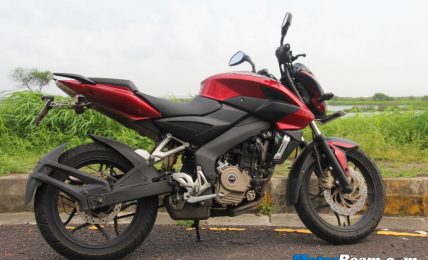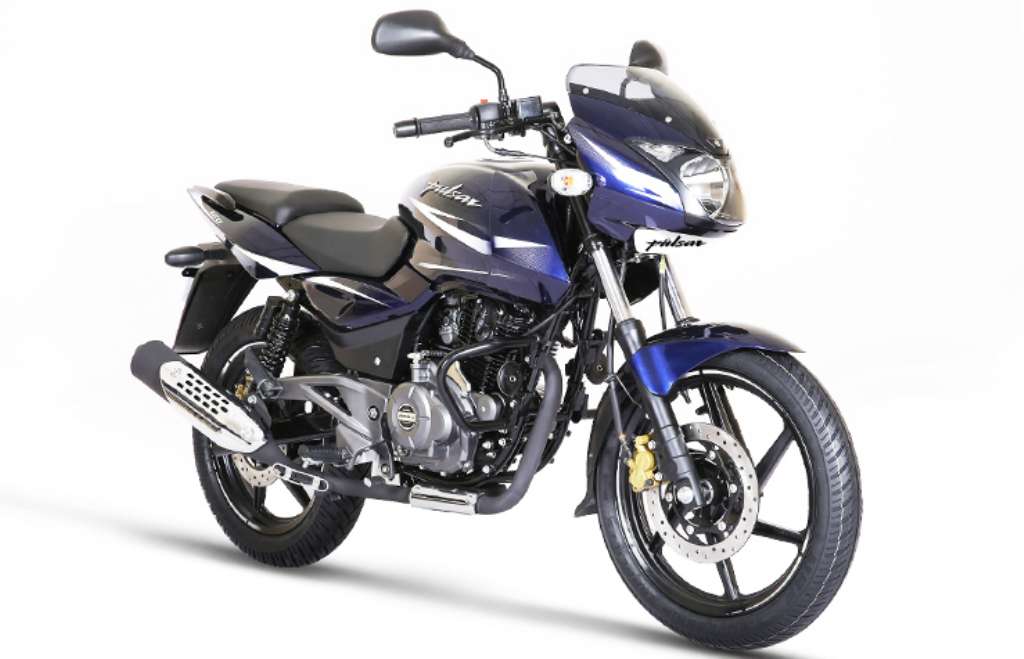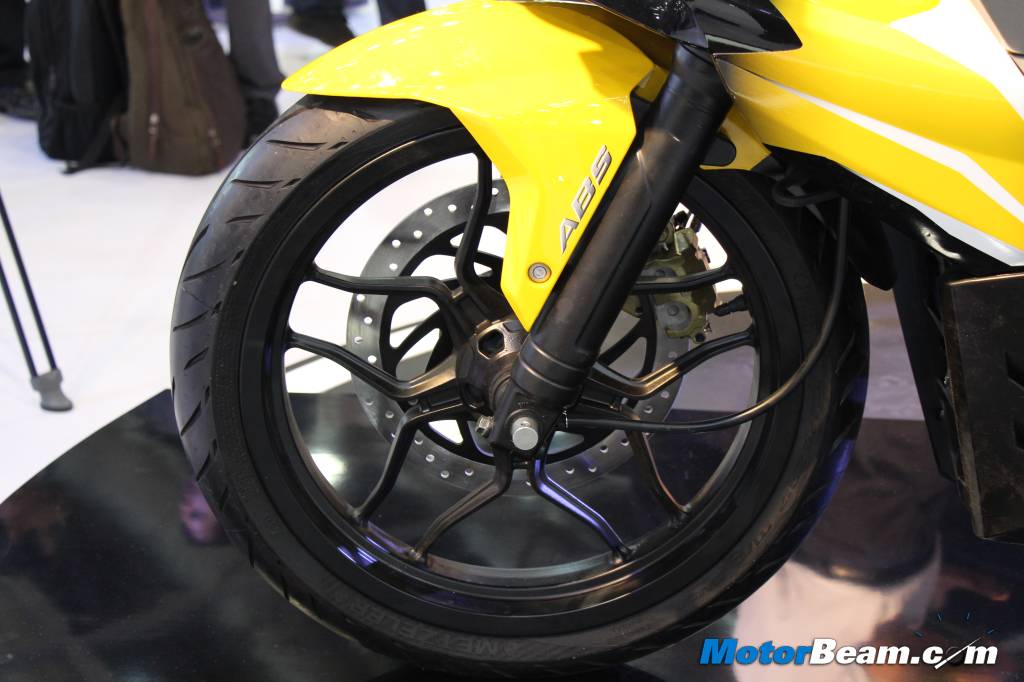Text – Mohit Soni; Pictures – Om Vaikul
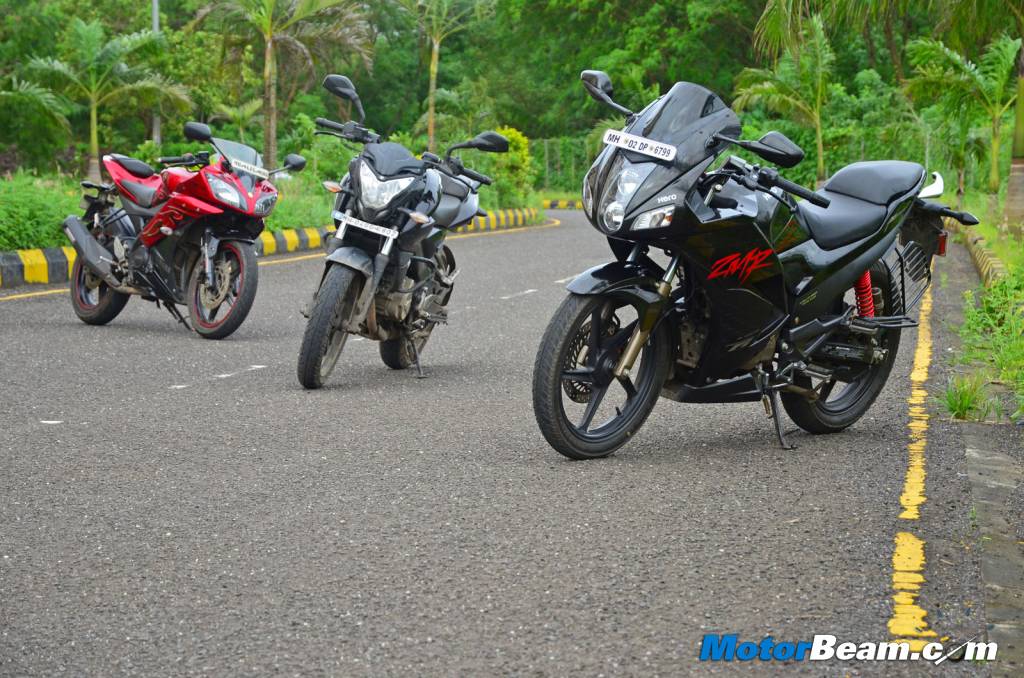
Shootout – Yamaha R15 vs Karizma ZMR vs Pulsar 200 NS
Price OTR Mumbai: Rs. 1,03,000/- (Pulsar 200 NS), Rs. 1,16,720/- (Hero Karizma ZMR), Rs. 1,27,350/- (Yamaha R15)
These budget sporty motorcycles may be different but they fall in the same category
Performance biking and pricing go hand in hand. This time we are being very specific of what we are about to do. These motorcycles you see above come in the same price bracket and it is you who keeps on asking us which bike you should buy from these. But people say how can you compare these motorcycles despite them not even falling in the same displacement category. Well, tell that to the manufacturer who makes these bikes with different “cc” numbers and either charge too much money, give you unmatched value or offer same or very less performance for the same money. Pricing is done accordingly because it is the most important factor and is the reason why the aam junta keeps asking us this question. What we have here today are performance motorcycles which are a cult in our nation. The Yamaha YZF-R15, a bike which is known for its handling and adequate performance. The Hero Karizma ZMR is for people who want comfort with extra horsepower and want to make weekend trips faster and hence they choose this bike over a 150cc option. The Bajaj Pulsar as we know is capable of doing everything. It can give overwhelming performance as always and be fast while offering relaxed cruising. What the Pulsar did not excel at was handling and the 200 NS is now capable of giving so much more with its new chassis and suspension bits. So which of these similarly priced bikes win? Let’s find out!
Motor Quest: Hero MotoCorp sold 3679 units of the Karizma last month (both R and ZMR) while Yamaha sold 3326 units of the R15 in the same month. The Pulsar 200 NS also does similar numbers to the R15 but the Yamaha seems to be the leader in the segment as far as sales go, in spite of being the costliest and least powerful. While the Karizma was launched in 2003, the ZMR variant came in 2009 and was updated earlier this year. The Pulsar was launched in 2001 and the 200 NS came in 2012 while the R15 was launched in 2008 and the V2 was launched in 2011.
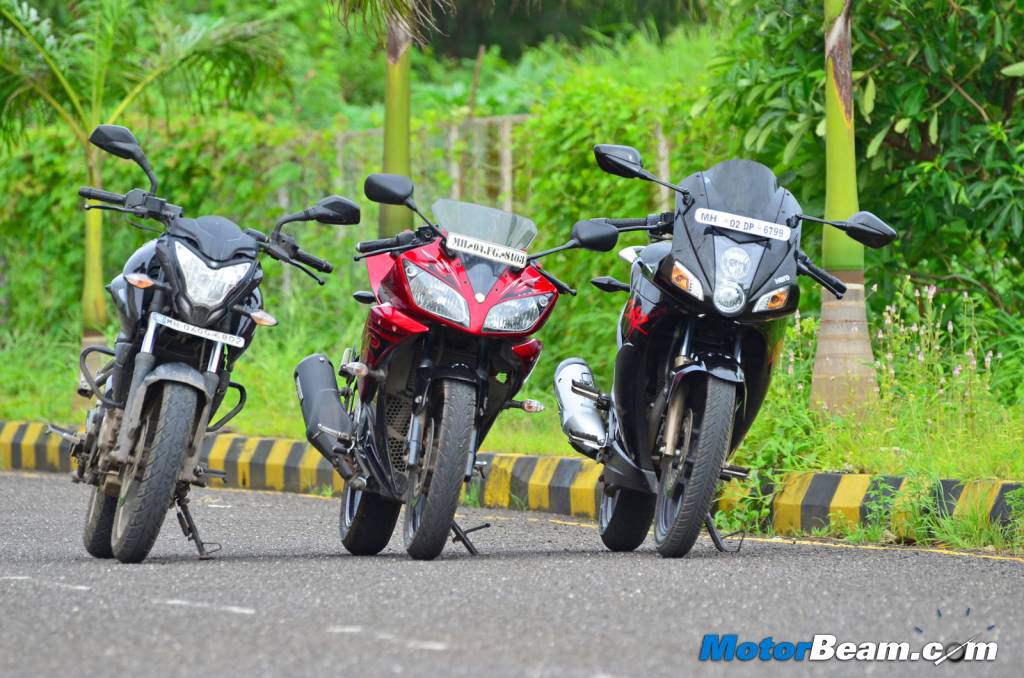
Styling – Let us start with the best looking bike of the lot. The Yamaha R15 is a stellar looking motorcycle. It is a Victoria Secret model between supermodels here. Nose-down, tail-up design looks stunning with twin-headlights at the front and well integrated and good looking LEDs at the rear. Full fairing with those three drawer compartments add to the purposeful aura which the YZF machine has. It looks poles apart from its predecessor and looks like its elder sibling that is the R6. The Pulsar as always with naked styling bleeds your eyes with those edgy lines, pumps your heart with that muscular tank and superbike inspired headlight turns heads 360 degrees till date, that is even after two years of launch.
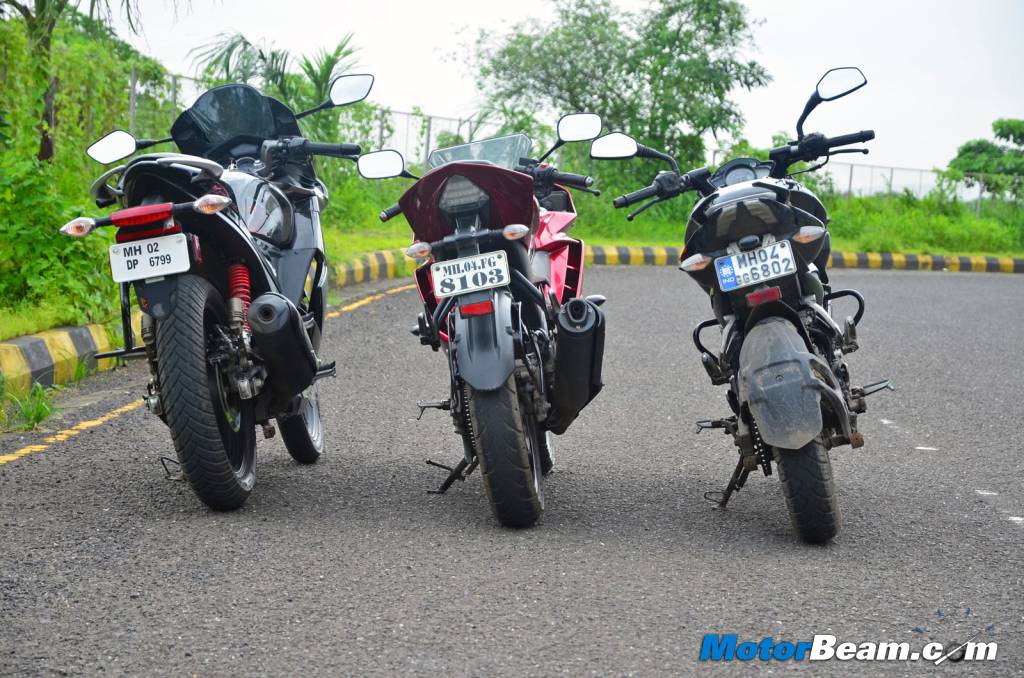
The rear is where the Pulsar 200 NS is not that exciting but it carries the traditional family tail light which is subjective to personal likes and dislikes. Coming to the Karizma ZMR, well what can we say. It is you people who have given it a proper thumbs down but in flesh it is not that bad. Front-end is a bit finicky and resembles an animal which is not inspirational in any way. There are good things such as the new side fairing which is very well executed with slashes and scoops in the lower section with well chosen graphics. The rear is something you can get used to very easily because it is exposed, sporty and the LED tail light look splendid at night and is far better than both contenders in terms of illumination as well.
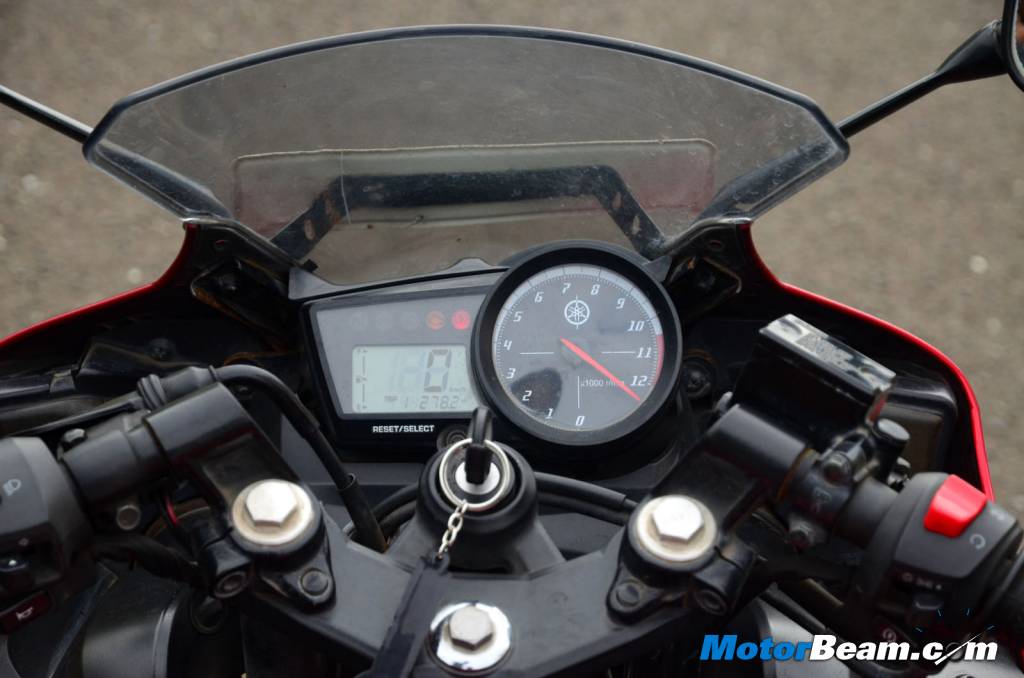
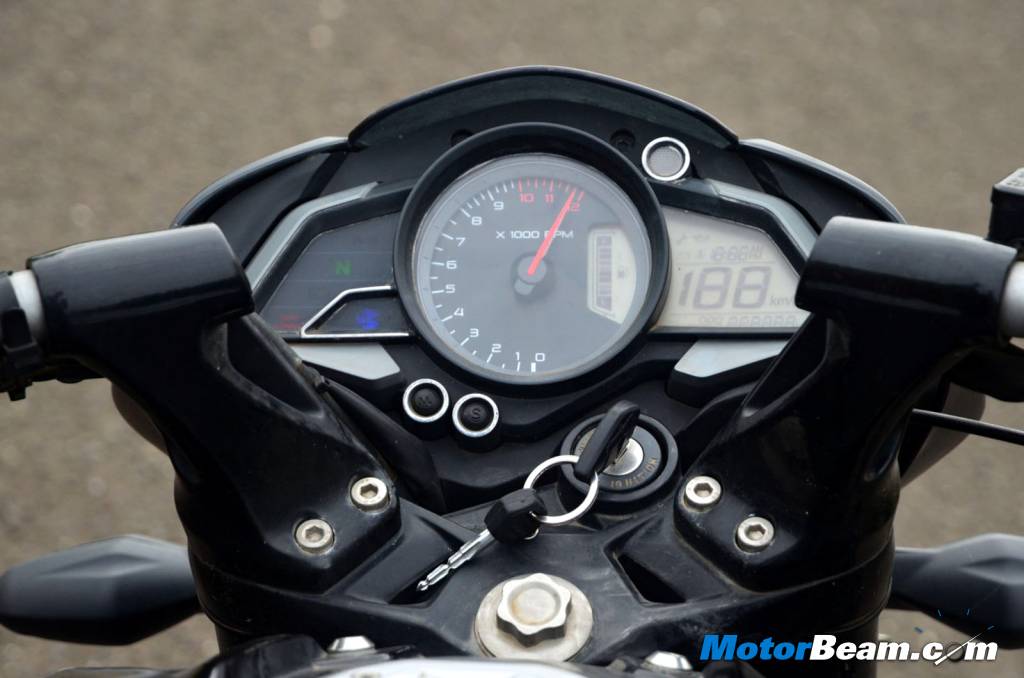
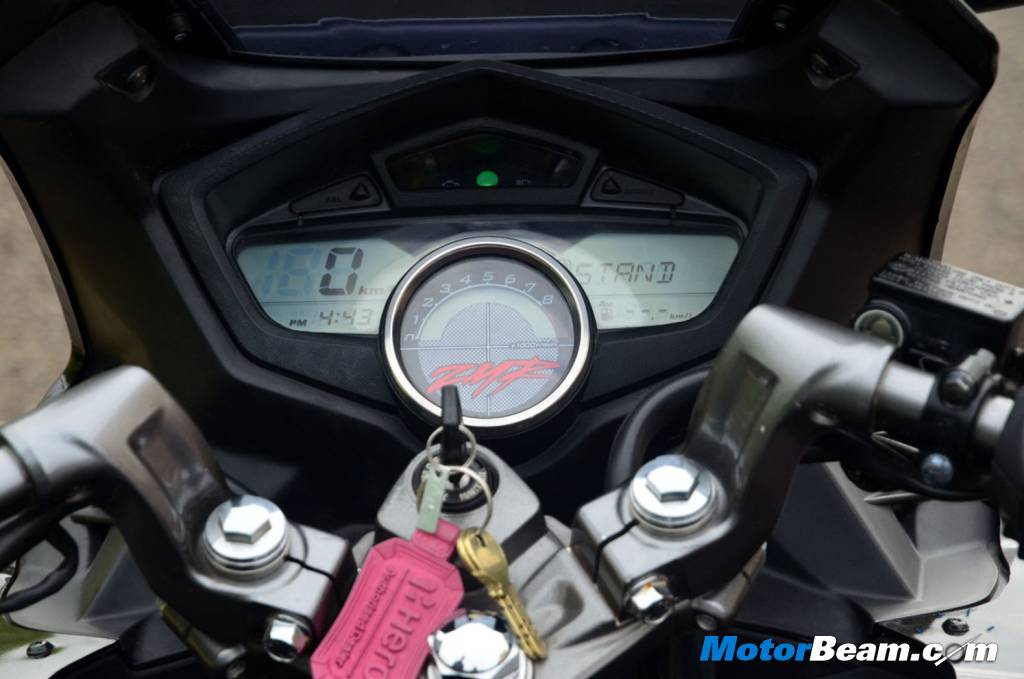
All of these clusters are well loaded but the one on the 200 NS scores a bit higher with extra essentials
Instrument Cluster And Switchgear – The Karizma ZMR is the only one here with a fully digital cluster which includes the tachometer as well. The ZMR has only two features above all these bikes which the instant fuel economy meter and welcome/good bye message. Rest of these bikes have two trip meters, clocks (missing on the R15) and regular tell-tale lights. The Yamaha R15 and Pulsar 200 NS have analogue tachometers. The Pulsar 200 NS has a shift light, battery indicator, service due indicator, side-stand indicator extra over the other two bikes. When it comes to switchgear, the ZMR still does not have an engine kill switch and the switches are already used on 150cc stablemates which come for Rs. 30,000/- less. The R15’s switchgear is excellent as always with all basic features which feel and look good too. The Pulsar 200 NS also has what the R15 has but it also has additional blue back-lit switches which are needless to say, still bespoke to Bajaj/KTM bikes as a cool feature.
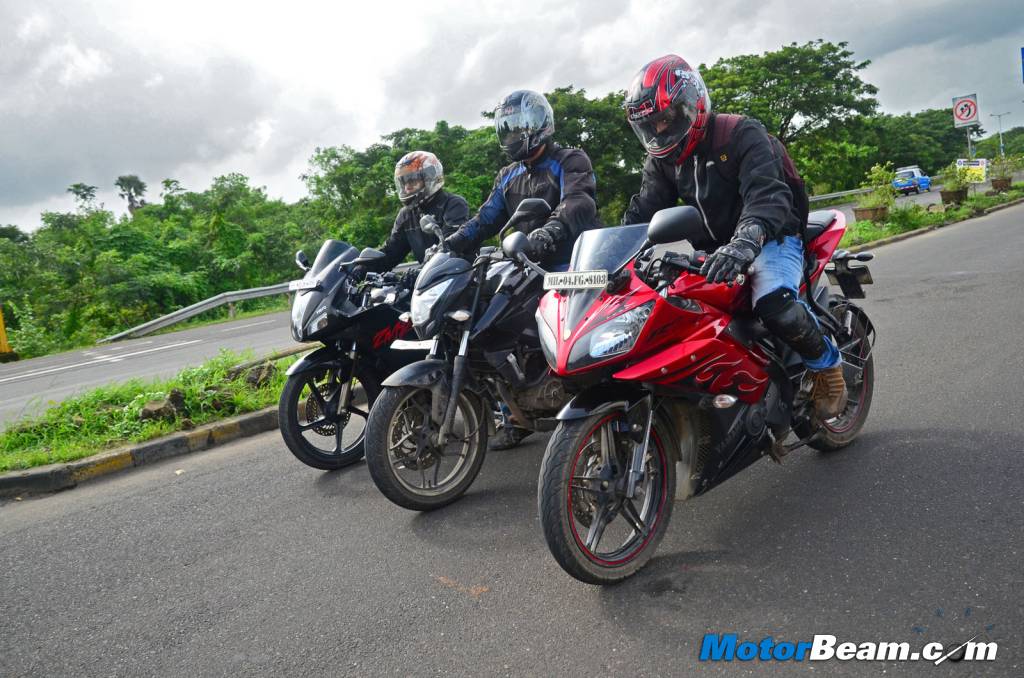
Ergonomics – All these three motorcycles offer low seat height and the Pulsar 200 NS is the one which suits tall riders quite well. The seats on the Karizma ZMR and Pulsar are extremely comfortable, well padded which is also because of their generous dimensions in terms of length and breadth. The R15’s seats are good but when it comes to the long-run, due to dedicated riding position and thin seats, it makes it not such a comfortable long-distance tourer, it also has the worst pillion seat here. Mirrors are well positioned on all these bikes. Foot-pegs are rear-set on all these bikes as well and it’s the Karizma and Pulsar 200 NS which allow more space to move around and are spacious enough for those long rides.
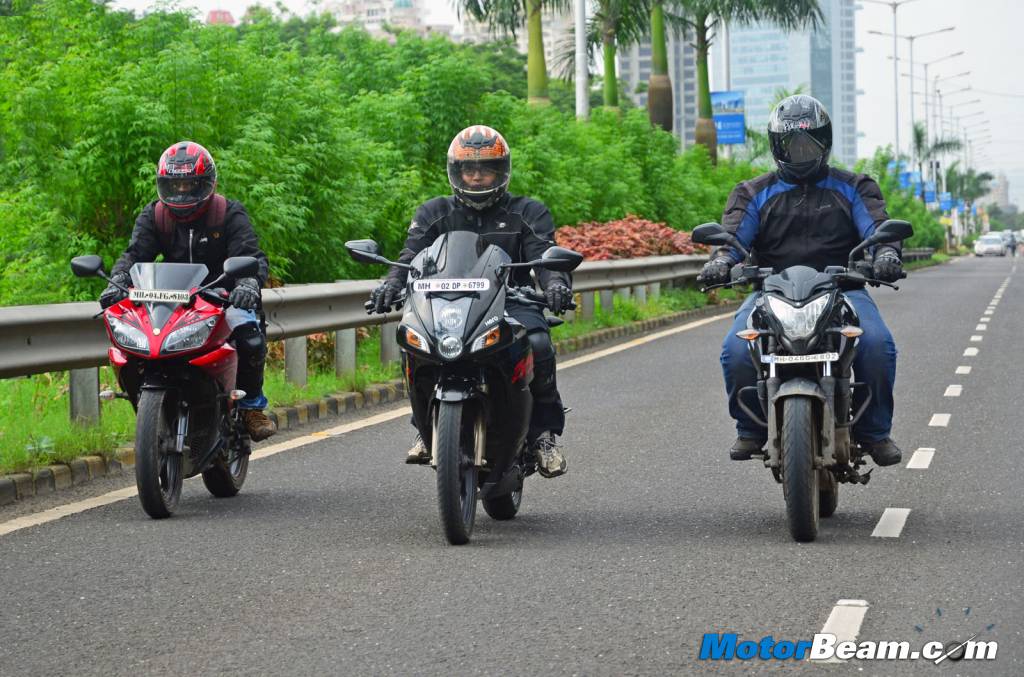
Performance – Let’s get over with the fastest and slowest in the beginning itself. The Pulsar 200 NS takes 10.20 seconds to do the 0-100 km/hr sprint while the R15 does it in 11.89 seconds and the new Karizma ZMR does it in 11.26 seconds, making it much faster than the old model. The Pulsar 200 NS is the fastest bike here with a genuine top speed of 135 km/hr. Meanwhile the R15 and Karizma ZMR both manage 130 km/hr on the VBOX, making them neck to neck in terms of top speed. The bump in power to the Karizma ZMR has helped it beat the R15 in acceleration.
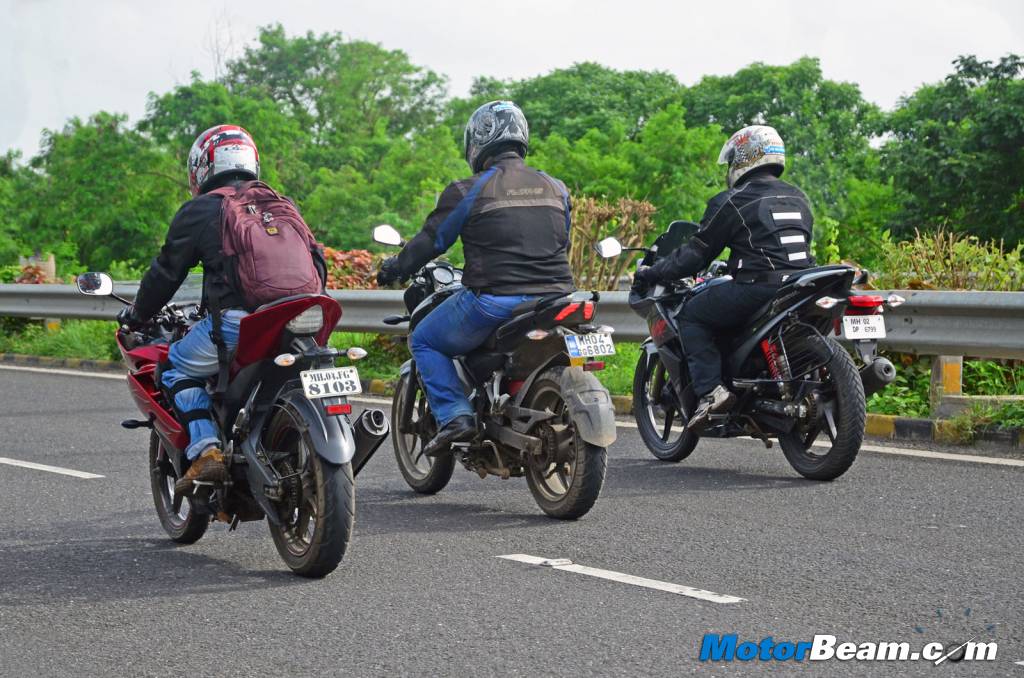
The engine on the R15 and 200 NS are proper screamers and rush to their redlines with an aggressive sounding
The Yamaha R15 is a bike which now has very good low and mid-end torque but has lost the top-end thrust which the old bike had due to taller gear ratios and smaller sprocket. It is still the most refined bike here with excellent NVH, followed by the Karizma and Pulsar 200 NS. The Karizma ZMR is the still the same with its 2-valve mill, so the low and mid-end punch is what it offers best. The Pulsar 200 NS with more power has excellent city ride-ability and the mid and top-end surge is just surreal because the way the Pulsar engine spins is almost as fast as the KTM, redlining is not an issue either. Both these Japanese engines spin fast too but the Pulsar is just way more ahead thanks to the crankshaft and flywheel which comes directly from KTM, including the gearbox which has tweaked ratios (taller) over the Duke 200.
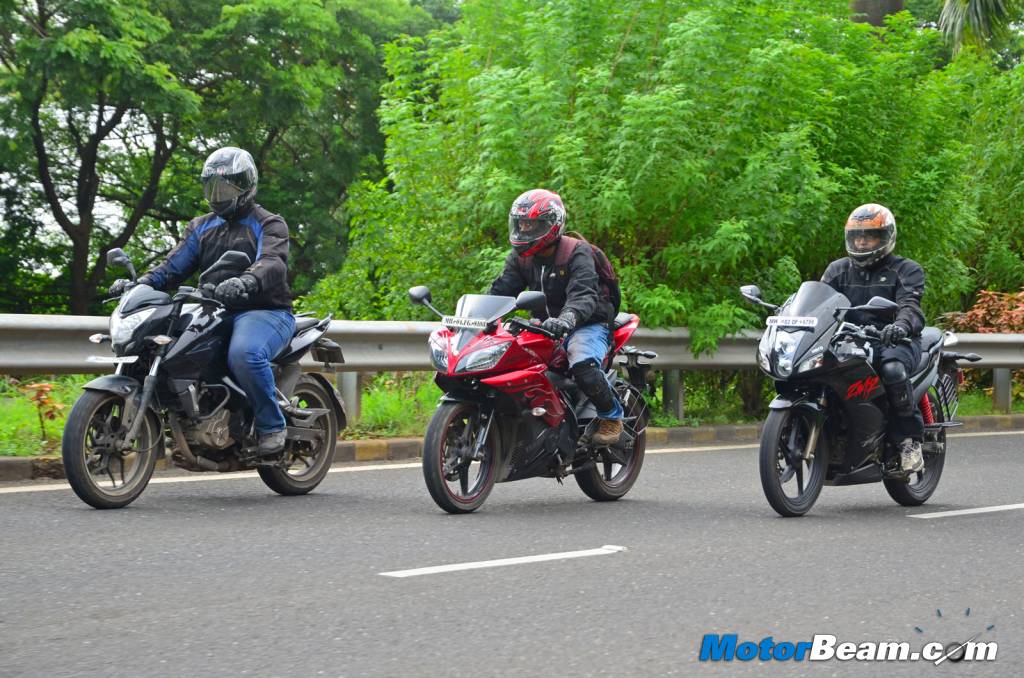
The R15 and Pulsar 200 NS have a 6-speed gearbox while the Karizma ZMR still offers a 5-speed unit, the one on the Yamaha being the smoothest here. Also the Pulsar and R15 offer liquid-cooling while the Karizma uses an oil-cooler. Both Japanese bikes are fuel-injected, full-faired while the Pulsar uses a carburettor with naked styling. Proper response and missing things over the Japanese contenders will come in the form of the Pulsar 200 SS. When it comes to fuel-efficiency, all these bikes are capable of giving 40 km/l on the highway and 35-38 km/l in the city. All in all, all of this makes the Pulsar 200 NS the clear winner because it offers city ride-ability, drag racer performance and highway cruising ability in a comfortable, linear manner.
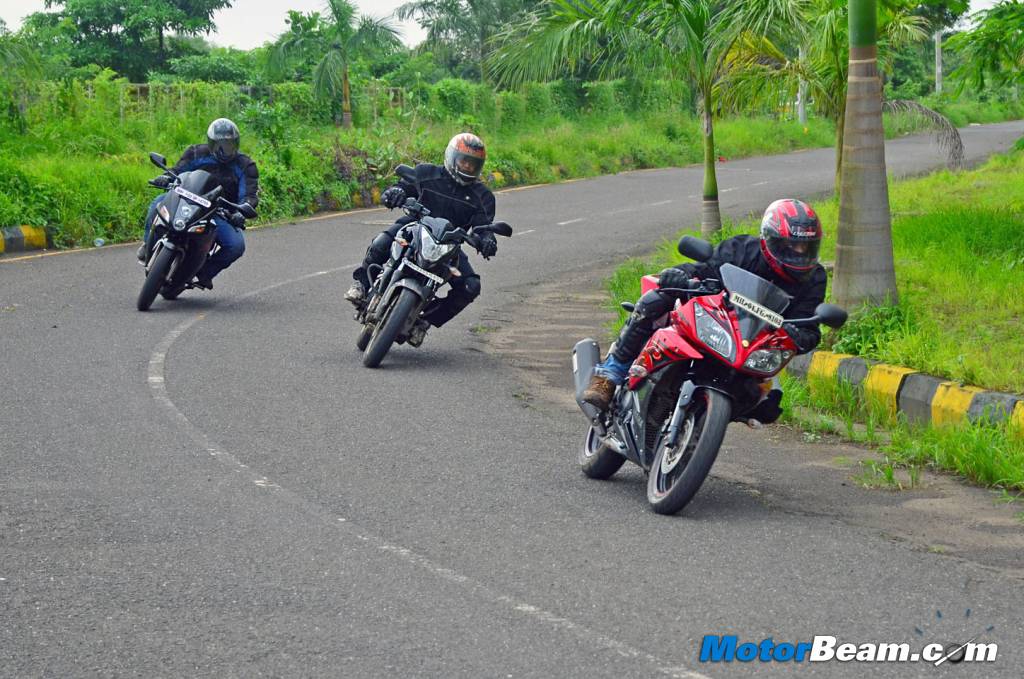
Riding Dynamics – Oh boy, this is the third time we have said this and we have to say it again. If any Yamaha product comes in a comparo, it just wins the dynamic round by a good margin. The R15 is the most dynamically sorted out bike in the Indian motorcycle industry till date. Sure the Dukes are even more exciting and have great balance but the R15 has its special place because the way it gives confidence to a newbie rider to push harder and harder is unmatched. Lots of grip, fast and crisp turn-in of the front-end along with feeling agile and nimble while being solidly planted at high-speeds with immaculate mid-corner balance. Needless to say that every action of the bike gives immense feedback to the rider which is the party piece of the R15. The radial fat tyres with aluminium swing-arm ensures throwing it in corners again and again on demanding roads makes you the Joker of Batman, constant smiling despite doing things right or wrong. However, this is where competition comes in when it comes to the corporate world. The Pulsar 200 NS is a revolutionary product from Bajaj. The best engine package now comes with same perimeter frame as the R15 but the tuning is for the street-fighter character of the bike.
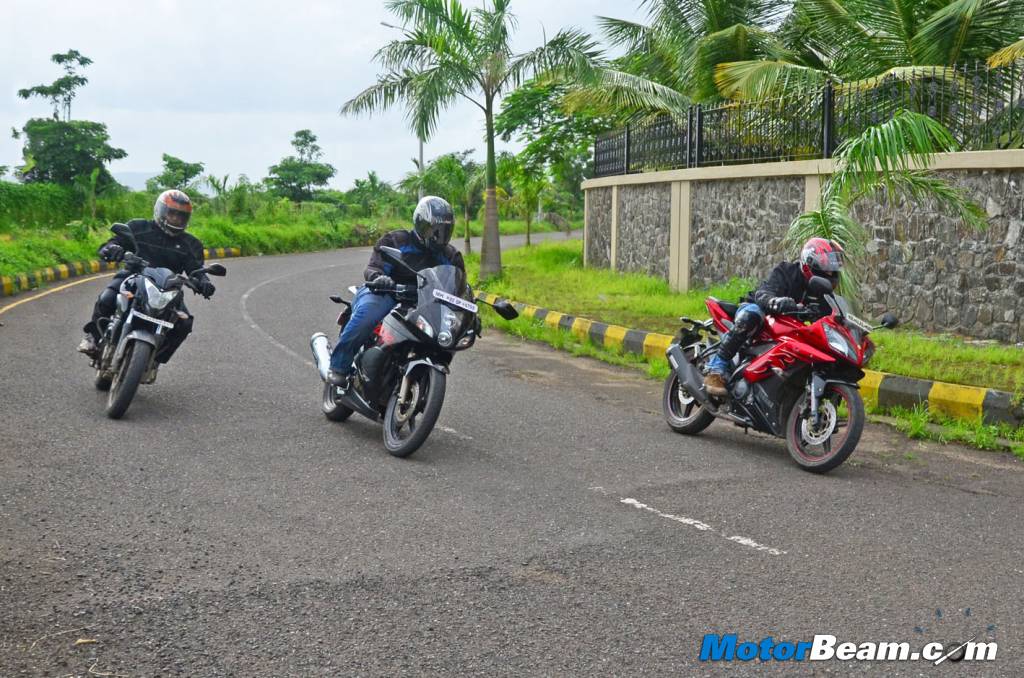
The Pulsar 200 NS with almost identical wheelbase as the R15, feels agile, turn-in is good but not as sharp as the R15 due to the raked out front-end. Stability in a straight-line is really good and it stays planted and sorted when it comes to mid-corner stability as well. The only major problem with the NS are the tyres. The tyres don’t let you extract the real potential of the Pulsar 200. As we know, it has almost R15 level of potential. Riders who have changed the tyres enjoy the motorcycle so much that they swear by their bike’s dynamics. Getting same type of rubber as the R15 can change your perspective towards its handling or even better if you can swap them for Pirellis of the same dimension.
The R15 makes up for the lack of grunt with its fantastic chassis balance, it has excellent brakes
The Karizma ZMR though, still has the single-downtube frame with the same suspension setup (no monoshock here). Now with fatter rubber on-board there is a noticeable difference on how the suspension behaves which in turn makes the chassis much more apt for the role. The fat rubber definitely lends more grip and aids in handling and you can choose to lean hard or go fast as any track day master would tell you to. The suspension is on the softer side but you feel it only at the limit. Taking sweepers and corners is far more fun and a much more stable act than before. A definite improvement over the previous bike but no where close to offering fun and sure-footed handling as its other two dynamically rich friends here. Ride quality on all these bikes is good and provide a good amount of comfort on our broken roads but the R15 is the best of the trio. The Yamaha also has the best brakes, the 200 NS having stronger stopping power but the tyres don’t grip as much as the R15’s stickier rubber.
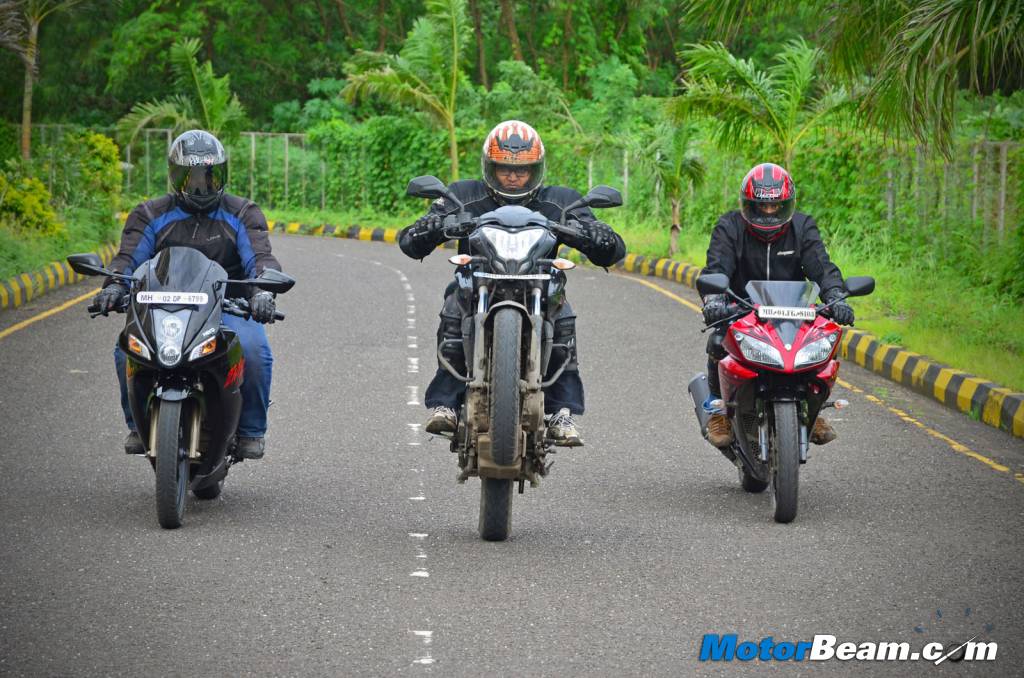
Verdict – Well the Pulsar 200 NS is faster, cheaper, easy on the pockets and is the most fun to ride bike which makes it the undeniable choice in this segment at this price point. All these manufacturers provide a fuss-free ownership experience which includes cheap running costs and good fuel efficiency. As we all know, the Pulsar 200 NS has being doing the exact same numbers as the two other bikes in the segment which means there is a place for the other two bikes as well. If you want style, dedicated ergonomics, dynamics, performance (as good as the Karizma ZMR), quality and proven reliability then there is the Yamaha R15 for you. If you prefer comfort, performance and then style (in that order), then the Karizma ZMR is for you. If you want almost everything offered by these two bikes and are on a tight budget, the Pulsar 200 NS comes into action without a second thought. Budget aside, the Yamaha R15 is our pick of the lot.
The Pulsar has always been at the pinnacle of affordable performance biking in India at a price which just begs you to go to the showroom and get one for yourself. In this shootout, the 200 NS makes the competitors at this price point feel outclassed in one way or the other but if budget no bar, the R15 is the one to pick.
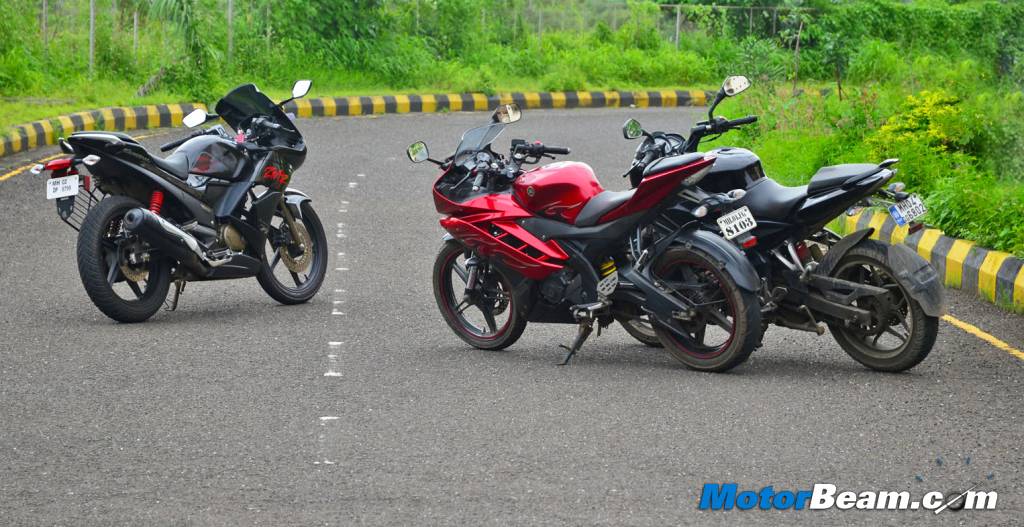
Further Reading –
Bajaj Pulsar 200 NS Ownership Report
Yamaha R15 Long Term Review
Hero Karizma ZMR Review


